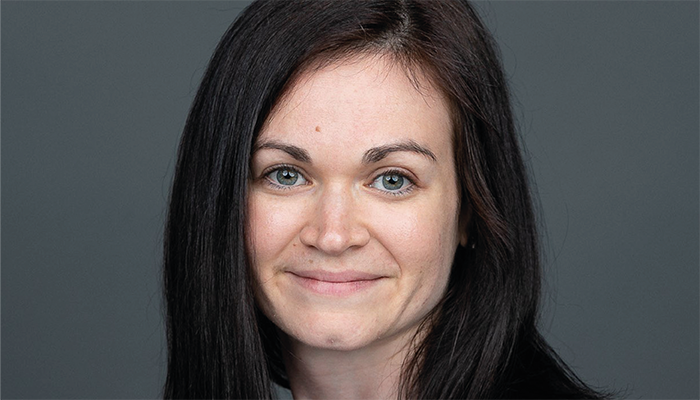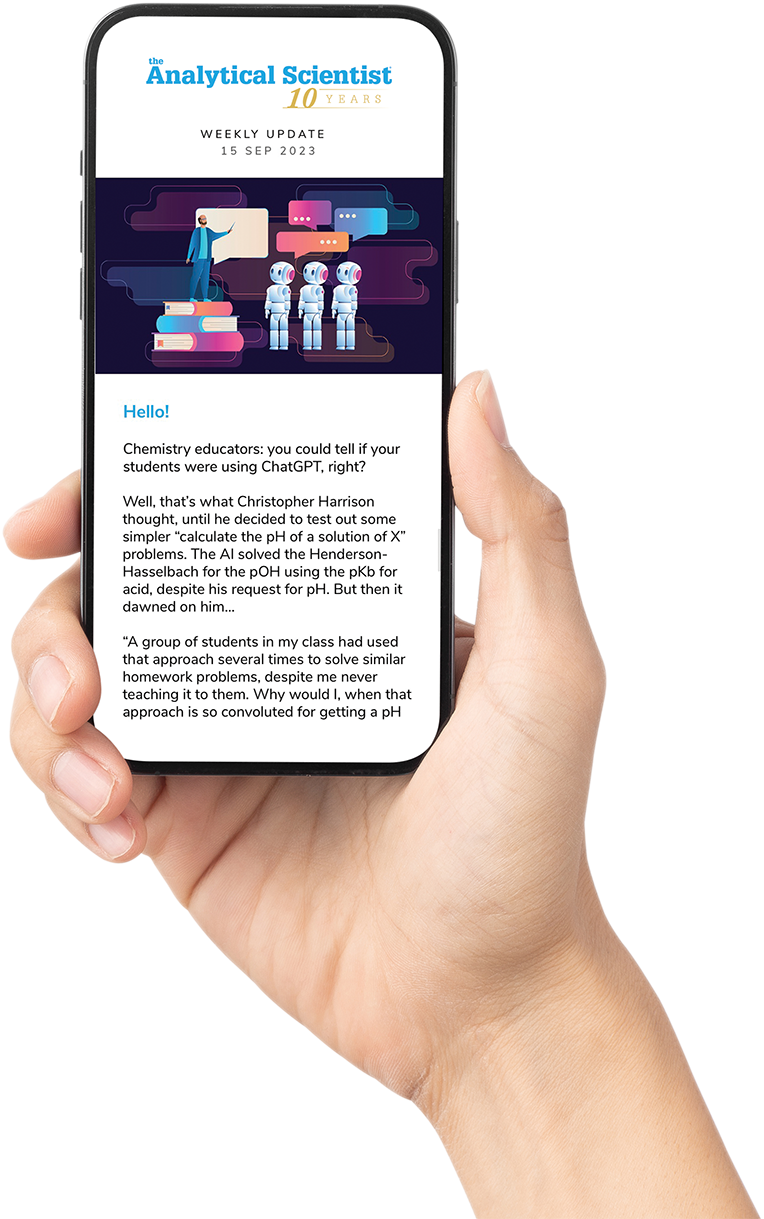
Credit: Anne Marie Smith
Welcome to the first in a series of articles shining a spotlight on the researchers and leaders working in industry to develop, commercialize, and deploy analytical technologies – transforming how we analyze and understand the world.
Here, we speak with Anne Marie Smith, Product Manager, Mass Spectrometry and Chromatography, at ACD/Labs. Smith began her career in the lab: she received her PhD in Chemical Biology from McMaster University, where she developed MALDI-MS based assays for screening kinases. And prior to joining ACD/Labs in 2016, becoming Product Manager in 2021, she held positions at Gilead Sciences and Piramal Healthcare.
Below, Smith shares insights on overcoming resistance to change, staying ahead in a rapidly evolving landscape, and why she thinks AI-driven analytics and automation are set to transform the future of analytical technology.
Your career started in the lab and now you're a Product Manager. Can you tell us how your scientific training and lab experience have shaped your approach to product development and management?
My scientific training provided the foundational knowledge I needed, while my hands-on lab experience allowed me to apply those principles in real-world settings, such as developing methods for pharmaceuticals and identifying impurities. This experience helps me understand scientists' challenges and informs my product development approach, ensuring I prioritize user experience and develop tools that meet their needs. There’s often a lack of tools for scientists to communicate effectively through the scientific medium, leading to reliance on reports and documents. This understanding has motivated me to develop tools that allow scientists to socialize their work more easily, reducing manual effort and ultimately giving them more time to focus on science, which is more valuable for the company.
Would your younger self be surprised if they could see you in your current role?
Yes, my younger self would be quite surprised to see me in my current role. Back then, I had little interest in technology – computers were just tools to help me get tasks done, and my primary focus was always on science. Before joining ACD/Labs, I hadn’t even installed software myself. It’s been an exciting journey, and I’ve fully embraced the shift into the tech space. Along the way, I’ve developed a deeper understanding of human interactions and learned how to translate those insights into effective software solutions. Today, bridging the gap between scientific expertise and technology is a key part of what I do.
What is the most challenging aspect of your role?
One of the most challenging yet rewarding aspects of my role is identifying and addressing latent needs – the deeper, often unspoken challenges or desires that customers may not even recognize themselves. It's not just about understanding what users say they need but uncovering what they don’t yet realize is possible. As Henry Ford famously said, “If I had asked people what they wanted, they would have said faster horses.” Customers often focus on familiar solutions, but by addressing latent needs, we can create innovative alternatives that truly transform how scientists work. This process is challenging but inspiring, as solving these hidden needs can significantly improve workflows, spark breakthroughs, and change the way scientists approach their research.
What do you consider the biggest challenges in translating scientific technology into commercially viable products?
The biggest challenge in translating scientific technology into commercially viable products lies in addressing latent pain points while also navigating the rapidly evolving technology landscape. Identifying and solving these hidden pain points is critical, as they often reflect the unmet needs in the market. At the same time, technology is advancing quickly, making it essential to stay ahead of technical limitations and adapt solutions to meet both current and future demands. Scientific research often involves complex systems for data management, processing, and analysis, each requiring specialized software and robust server networks. Choosing the right resilient tools is key- software is developed, deployed, and ultimately relies on technology for its performance and scalability. Ensuring the product is both reliable and scalable while meeting market, regulatory, and user expectations is crucial for long-term success.
The analytical science sector is considered relatively conservative. Has this presented any challenges when bringing a new technique / technology to the market? If so, how have you tackled this?
Introducing new technology in the analytical science sector can be challenging, as it’s often met with resistance – like trying to fit a "rhinoceros in a fridge." Even more challenging is when there’s already an "elephant in the fridge" – an entrenched system that people are hesitant to disrupt. The key is identifying the "empty fridge," or areas where change is needed, making it easier to introduce new solutions. Some of this resistance can also come from a hesitation to implement unfamiliar technologies, so we address this by clearly demonstrating the real-world value of our solutions through data-driven studies that showcase their reliability and benefits. Building trust and credibility is essential, so we collaborate closely with industry experts, ensuring our technology addresses the latent needs of our customers while proving its worth in practical, everyday applications. This approach helps ease adoption and positions our solutions as a valuable step forward.
Do you have any tips for maintaining an innovative edge while ensuring technology remains scalable and meets regulatory and market demands?
To maintain an innovative edge while ensuring scalability and compliance with regulatory and market demands, at ACD/Labs we follow structured practices like the Software Development Life Cycle (SDLC) and emphasize "systems thinking," ensuring we understand the full impact of our decisions. A commitment to continuous improvement and innovation is systematically ingrained into our software development process, ensuring we balance novelty with practicality. We also embrace meta-innovation, which involves innovating not only within the product itself but also within the processes and methodologies that guide our work. This means constantly re-evaluating how we approach challenges, encouraging creativity in problem-solving, and fostering a culture of continuous learning and adaptation. By incorporating meta-innovation, we ensure that our solutions are not only forward-thinking but also scalable and sustainable in a rapidly evolving landscape.
What are the key qualities of an innovative team?
An innovative team excels by finding the right balance between novelty and practicality, ensuring that new ideas are both visionary and achievable. This balance is key to transforming abstract concepts into tangible solutions that meet real-world needs. Innovation isn't just about being creative; it's about knowing when to make, buy, or partner to bring the right solution to the table. Co-creation plays a central role in this process, as collaborating closely with clients and partners ensures that solutions are user-centric and tailored to address specific challenges. A diverse team with varied skills and strong communication fosters creativity and allows for calculated risk-taking. By maintaining high standards of quality and accountability, innovation can be made both impactful and sustainable. Ultimately, the ability to navigate the tension between pushing boundaries and ensuring practicality is what drives successful, scalable innovation.
As someone who has been involved in both science and product management what trends do you see shaping the future of analytical technologies – especially in the life sciences and pharmaceutical industries?
Digital transformation is a major trend shaping the future of analytical technologies, particularly with digital twins for analytical processes. This shift aims to digitalize study design, execution, and result dissemination, streamlining collaboration and improving efficiency across organizations. At the heart of this transformation is the integration of artificial intelligence (AI) and machine learning (ML), which enhance data analysis and decision-making and provide more accurate insights and predictive models to accelerate drug discovery. These technologies enable a more dynamic, real-time approach to research by automating tasks and optimizing workflows. Additionally, the rise of automation, lab digitalization, and cloud computing is further improving collaboration and scalability, helping to reduce development times and costs. These innovations are driving a new era of faster, more precise, and cost-effective advancements in healthcare, reshaping the way research is conducted, and treatments are developed.
What is missing from the analytical technology toolkit today?
Analytical technology toolkits today often lack the level of user customization needed to fully optimize workflows. Users should be able to personalize their digital environments to better suit their specific needs, creating a more efficient and effective experience. While many tools provide integration, automation, and data interpretation, there’s room for improvement in areas like advanced AI-driven pattern recognition and predictive analytics. These technologies could help users identify subtle trends or anomalies that traditional methods often miss, enhancing decision-making.
Moving forward, I believe that a simplified, accessible data science toolkit will be essential. This toolkit would empower users to harness automation and advanced analytical capabilities, making complex data analysis more approachable and actionable for people at all levels of technical expertise.
For scientists looking to move from the lab into roles that blend science with business, what advice would you offer?
A scientific background provides a strong foundation in systems thinking, which is essential for problem-solving both in the lab and in business. This mindset – where you assess the big picture, understand interdependencies, and analyze potential risks and outcomes – transfers seamlessly to business roles. Although the specific domain may shift, the core principles of scientific discovery, such as observation, analysis, and experimentation, remain highly applicable. Transitioning from the lab into business roles can be challenging at first, but it’s incredibly rewarding as it offers opportunities to apply your scientific expertise in new ways, driving business strategies and fostering innovation.




